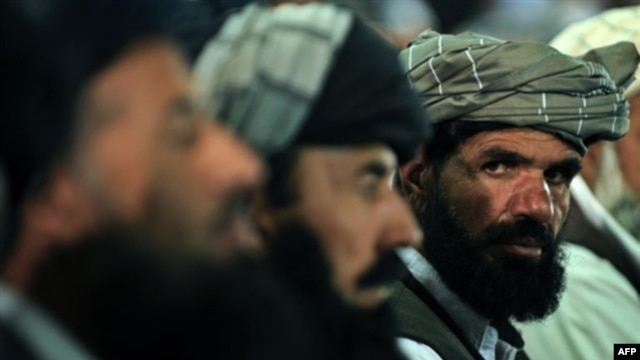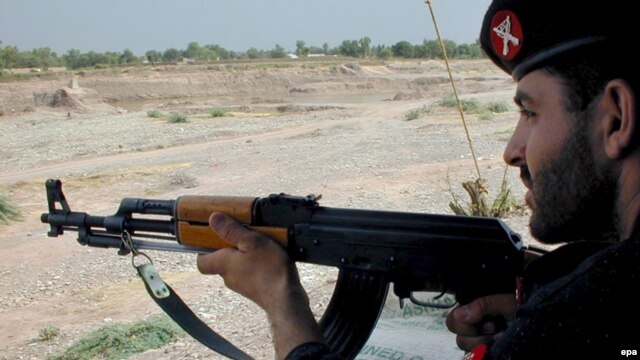With recent cross-border attacks by U.S. forces inside Pakistan's tribal areas, the focus of the war on terror is shifting to the Pashtun regions of Pakistan and is likely to intensify.
But the Pashtun intelligentsia -- on both sides of the Afghan-Pakistani border -- say they want peace and are asking for a better understanding of the dynamics of their homeland. They say force alone is unlikely to solve their problems, which they say are entirely unrelated to terrorism and the violence that comes with it.
Nader Khan Katawazai, a member of the Afghan parliament in Kabul, says that international efforts against terrorism in Afghanistan are narrowly focused on fighting the insurgents and have failed to address critical political, social, and economic issues responsible for the growth of extremism in the Pashtun regions.
"The lack, or low educational levels in Pashtun regions is a primary factor in sustaining the instability. Pashtun youth can easily be recruited by anyone because of the lack of education," Katawazai says.
"Similarly, unemployment leads to resentment among youth. These factors have accumulated into such a state that the Afghan government is only limited to district and provincial headquarters, while its opponents control the rest of the territories."
Front In War On Terror
An estimated 40 million-50 million Pashtuns live in Afghanistan and Pakistan. Mostly organized into dozens of tribes, the Pashtuns live in the heart of the South-Central Asian region, which since the terror attacks of September 11, 2001, has turned into the central front in the war on terrorism. The group is often associated with extremist Taliban members and Pashtun tribes are accused of sheltering international terrorists.
Since the 1979 Soviet invasion of Afghanistan, the region has seen more than 1 million Pashtuns killed and millions more displaced in various rounds of fighting in that country.
But over the past five years, fighting has also devastated large parts of the once peaceful Pashtun border regions in Pakistan. Thousands of government soldiers, militants, and civilians have been killed.
These already impoverished regions now face a near economic collapse as a humanitarian crisis develops. The fighting in Bajuar and Kurram tribal districts in the Federally Administered Tribal Areas (FATA) has already displaced some 300,000 civilians during the past few weeks -- some of them even seeking refuge in Afghanistan.
Local leaders say that millions of Pashtuns in the area are the biggest victims of terrorism.
Afrasiab Khattak, a senior leader of the Pashtun Nationalist Awami National Party in Peshawar, says that on both sides of the border "Pashtuns have paid a very heavy price in the war against terror."
"Their children, women, old and young men have been killed. Their clerics and political leaders have been killed. And their schools, roads, and homes have been destroyed in this fighting," Khattak says.
Khattak, who is also the peace envoy of Northwest Frontier Province (NWFP) government, survived a bomb attack at a party election rally in February that killed 25 and injured more than 70 people. He says that the presence of terrorist sanctuaries in the Pashtun regions of Pakistan is the result of larger regional and international geostrategic games being played on their soil for the past three decades.
Al-Qaeda's Home Turf
Pashtuns came to the fore when the former Soviet Union invaded Afghanistan in 1979. They formed a large part of the anti-Soviet Afghan resistance that had Western and Arab support but was organized along religious lines or "jihad" against the "infidel" Soviet invaders.
However, the jihad in the 1980s also gave birth to Al-Qaeda. Though forged in the Pashtun city of Peshawar, it was mostly a transnational Arab network committed to fighting international Islamist causes. After being pushed out of Sudan in the mid-1990s, Al-Qaeda leader Osama bin Laden established his headquarters in the Pashtun regions of southern and eastern Afghanistan.
In late 2001, a U.S.-led military campaign against Al-Qaeda and their Taliban hosts toppled the Taliban regime and forced Al-Qaeda to look for new safe havens across the border in Pakistan's Pashtun-populated FATA and NWFP regions. Finding and destroying these sanctuaries now appears to be a top U.S. military priority.
Given such a grim assessment of the situation on the ground, some experts believe that the new, aggressive U.S. strategy aimed at Al-Qaeda and Taliban leaders inside Pakistan is unlikely to work.
Barnett Rubin, an Afghanistan expert at New York University's Center on International Cooperation, says that the administration of U.S. President George W. Bush looked at the terrorism problem only as a military problem while ignoring its political and economic aspects.
He says that it is encouraging that the United States is now looking at Pakistan and Afghanistan as an integrated problem. But he says that more needs to be done.
"The chances of success of such a new military strategy, without an accompanying political, diplomatic, and economic strategy, are zero," Rubin says. "And in all likelihood it will not succeed in really significantly hampering the Taliban and Al-Qaeda operations, but it might solidify the opposition to the U.S. in the area."
Impoverished Economy
Malik Aman Kasai, a political commentator in the southwestern Pakistani city of Quetta, says that regional cooperation between the governments in Kabul and Islamabad will mean little unless the impoverished Pashtun economy is transformed and they are given citizenship rights.
Kasai blames Pakistan's "permanent establishment" made up of its civilian and military bureaucracy for the ongoing suffering of the Pashtuns in both Pakistan and Afghanistan. He says that this ruling elite has deliberately kept the Pashtuns marginalized in Pakistan. And the opportunities provided by the complicated geopolitics in the region, he says, also enabled the elite to influence events in Afghanistan in a negative way.
The ruling elite "are like our mortal enemies. They are not sparing our houses or our mosques. They are not allowing any businesses or factories to flourish in the Pashtun regions. They have turned us into guns for hire and the Taliban," Kasai says.
Rubin says that a political strategy aimed at separating Taliban and other local armed groups from Al-Qaeda and international terrorism is needed.
"We need to find a way to separate this global threat from the local problems we are having in that area so that we don't get into a war with the people who live there," Rubin says.
"Ninety-five percent of those people, if not more, are not a threat to the international community. Except insofar as the international community is doing something in their areas that they object to."
Back on the ground, the prospect of the conflict intensifying with cross-border attacks from U.S. forces is a harrowing thought to many people.
Residents of the western city of Peshawar face uncertainty and misery because of the ongoing fighting between extremists and Pakistani security forces in parts of the FATA and the NWFP.
Nausheen, a young Pashtun school teacher in Peshawar, says she is already under stress because of the insecurity and high inflation in the city. Like many in the region, she tells RFE/RL that a U.S. military campaign inside Pakistan is the last thing she wants to see.
"Our country can defend itself. We don't need [the U.S. military] to defend us," she says.



